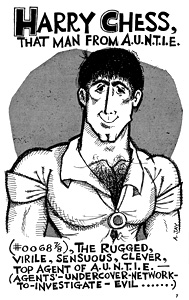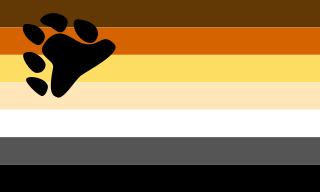
In gay culture, a bear is a larger and often hairier man who projects an image of rugged masculinity.
LGBT slang, LGBT speak, queer slang, or gay slang is a set of English slang lexicon used predominantly among LGBTQ+ people. It has been used in various languages since the early 20th century as a means by which members of the LGBTQ+ community identify themselves and speak in code with brevity and speed to others. The acronym LGBT was popularized in the 1990s and stands for Lesbian, Gay, Bisexual, and Transgender. It may refer to anyone who is non-heterosexual or non-cisgender, instead of exclusively to people who are lesbian, gay, bisexual, or transgender. To recognize this inclusion, a popular variant, LGBTQ, adds the letter Q for those who identify as queer or are questioning their sexual or gender identity.
Faggot, often shortened to fag, is a term, usually a pejorative, used to refer to gay men. In American youth culture around the turn of the 21st century, its meaning extended as a broader reaching insult more related to masculinity and group power structure.
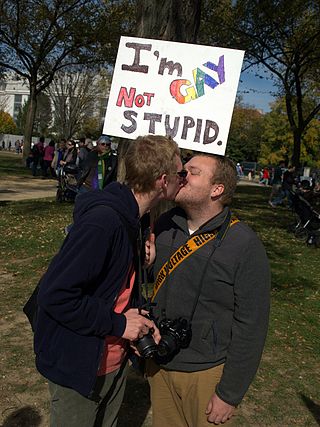
Terms used to describe homosexuality have gone through many changes since the emergence of the first terms in the mid-19th century. In English, some terms in widespread use have been sodomite, Achillean, Sapphic, Uranian, homophile, lesbian, gay, effeminate, queer, homoaffective, and same-gender attracted. Some of these words are specific to women, some to men, and some can be used of either. Gay people may also be identified under the umbrella terms LGBT.

Gay literature is a collective term for literature produced by or for the gay community which involves characters, plot lines, and/or themes portraying male homosexual behavior.
Camp Records was a record label based in California in the 1960s that specialized in producing anonymous gay-themed novelty records and singles, mostly sold out of the backs of beefcake magazines.
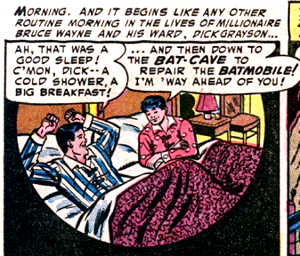
In comics, LGBT themes are a relatively new concept, as lesbian, gay, bisexual, and transgender (LGBT) themes and characters were historically omitted from the content of comic books and their comic strip predecessors due to anti-gay censorship. LGBT existence was included only via innuendo, subtext and inference. However the practice of hiding LGBT characters in the early part of the twentieth century evolved into open inclusion in the late twentieth and early twenty-first centuries, and comics explored the challenges of coming-out, societal discrimination, and personal and romantic relationships between gay characters.
Gay is a term that primarily refers to a homosexual person or the trait of being homosexual. The term originally meant 'carefree', 'cheerful', or 'bright and showy'.

Erotic comics are adult comics which focus substantially on nudity and sexual activity, either for their own sake or as a major story element. As such they are usually not permitted to be sold to legal minors. Like other genres of comics, they can consist of single panels, short comic strips, comic books, or graphic novels/albums. Although never a mainstream genre, they have existed as a niche alongside – but usually separate from – other genres of comics.
Fruit, Fruity, and Fruitcake, as well as its many variations, are slang or even sexual slang terms which have various origins. These terms have often been used derogatorily to refer to LGBT people. Usually used as pejoratives, the terms have also been re-appropriated as insider terms of endearment within LGBT communities. Many modern pop culture references within the gay nightlife like "Fruit Machine" and "Fruit Packers" have been appropriated for reclaiming usage, similar to queer.

The Man from C.A.M.P. is a series of ten gay pulp fiction novels published under the pseudonym of Don Holliday. The original nine were written by Victor J. Banis between 1966 and 1968; a tenth by an uncertain author appeared in 1971. The series first emerged during a period when gay paperback titles began spoofing popular genre fiction. As such, they are part of the great gay paperback explosion that "catered to most every taste in men's genre fiction," including detective stories and spy thrillers. According to Banis, the series was inspired by the characters Batman and Robin, and is a spoof of the James Bond series and the television show The Man from U.N.C.L.E.
William Ward (1927–1996) was a British erotic artist. He is best known for his strips featuring bear-like men and in particular his Adventures of Drum series for Drummer magazine.
Edward Sagarin, also known by his pen name Donald Webster Cory, was an American professor of sociology and criminology at the City University of New York, and a writer. His book The Homosexual in America: A Subjective Approach, published in 1951, was considered "one of the most influential works in the history of the gay rights movement", and inspired compassion in others by highlighting the difficulties faced by homosexuals.
A mixed-orientation marriage is a marriage between partners of differing sexual orientations. The broader term is mixed-orientation relationship, sometimes shortened to MOR or MORE.

Dyke is a slang term, used as a noun meaning lesbian. It originated as a homophobic slur for masculine, butch, or androgynous girls or women. Pejorative use of the word still exists, but the term dyke has been reappropriated by many lesbians to imply assertiveness and toughness.
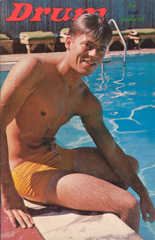
Drum was an American gay men's culture and news magazine published monthly in Philadelphia, Pennsylvania, featuring homoerotic photographs as well as news, book reviews, editorials, and fiction. It was published beginning in October 1964 by the homophile activist group the Janus Society as a continuation of the group's monthly newsletter. Edited by Clark Polak, the president of the Janus Society, the magazine represented Polak's radical approach to the homophile movement by emphasizing sexual liberation when other homophile organizations were focused on assimilating with straight society.
The Janus Society was an early homophile organization founded in 1962 and based in Philadelphia. It is notable as the publisher of Drum magazine, one of the earliest gay publications in the United States and the one most widely circulated in the 1960s, and for its role in organizing many of the nation's earliest LGBT rights demonstrations. The Janus Society takes its name from the Roman two-faced God Janus of beginnings, endings, and doorways. The organization focused on a policy of militant respectability, a strategy demanding respect by showing the public gay individuals conforming to hetero-normative standards of dress at protests.
In American mainstream comics, LGBT themes and characters were historically omitted intentionally from the content of comic books, due to either formal censorship or the perception that comics were for children and thus LGBT themes were somehow inappropriate. With any mention of homosexuality in mainstream United States comics forbidden by the Comics Code Authority (CCA) until 1989, earlier attempts at exploring these issues in the US took the form of subtle hints or subtext regarding a character's sexual orientation. LGBT themes were tackled earlier in underground comix from the early 1970s onward. Independently published one-off comic books and series, often produced by gay creators and featuring autobiographical storylines, tackled political issues of interest to LGBT readers.

Gay interpretations have been part of the academic study of the Batman franchise at least since psychiatrist Fredric Wertham asserted in his 1954 book Seduction of the Innocent that "Batman stories are psychologically homosexual". Several characters in the Modern Age Batman comic books are expressly gay, lesbian, or bisexual.
Drummer is an American magazine which focuses on "leathersex, leatherwear, leather and rubber gear, S&M, bondage and discipline, erotic styles and techniques." The magazine was launched in 1975 and ceased publication in April 1999 with issue 214, but was relaunched 20 years later by new publisher Jack MacCullum with editor Mike Miksche.
